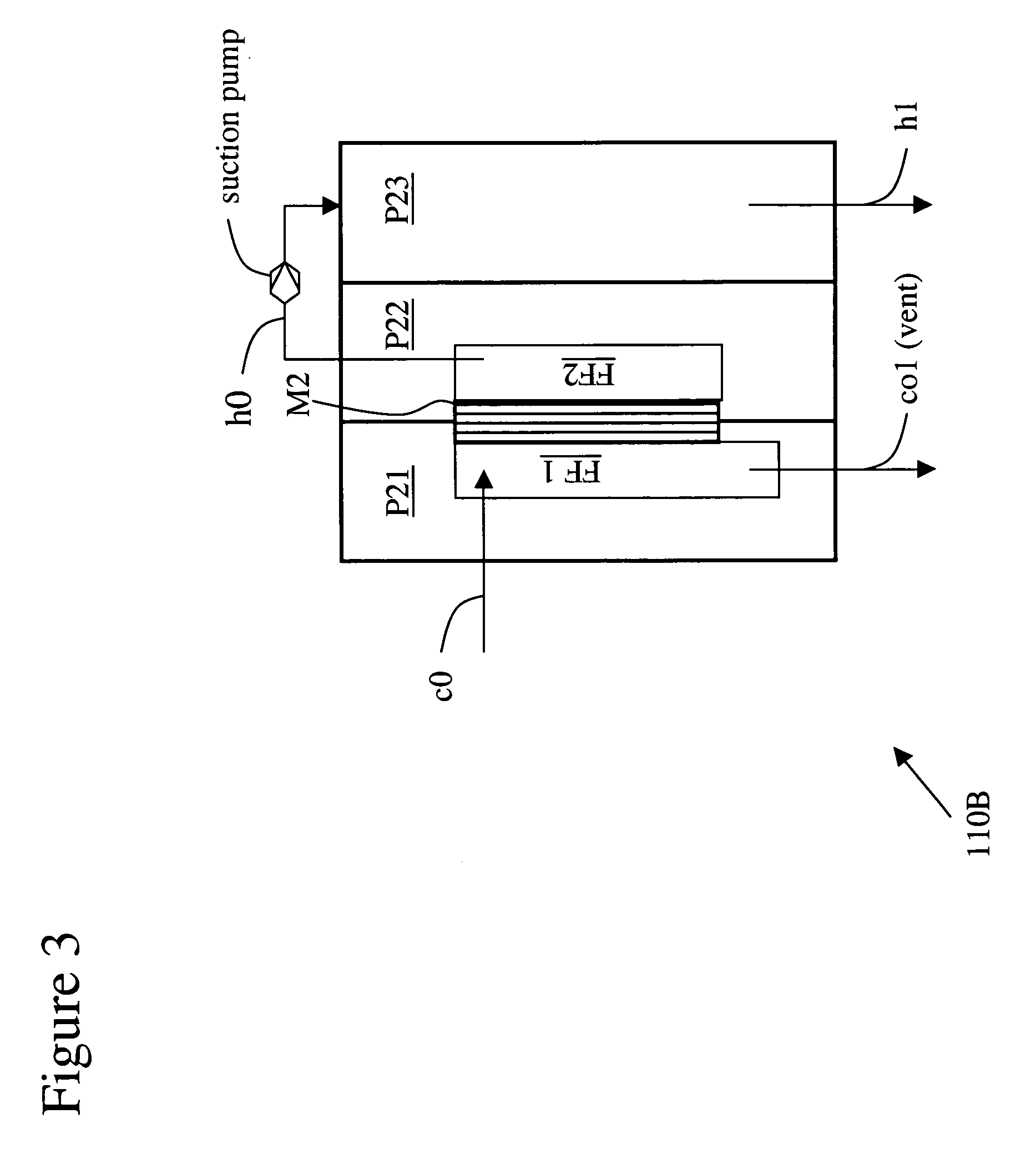Water management in a direct methanol fuel cell system
a fuel cell and water management technology, applied in the field of direct methanol fuel cells, can solve the problems of reducing the performance of the dmfc stack, consuming large amounts of power, and excess water can interfere with the diffusion of oxygen into the catalyst layer, so as to avoid bulky and power-consuming devices, and improve the overall efficiency of the dmfc system
- Summary
- Abstract
- Description
- Claims
- Application Information
AI Technical Summary
Benefits of technology
Problems solved by technology
Method used
Image
Examples
example 1
FIGS. 6-7 show an example of an approach for implementing the critical functions of water recovery from the cathode exhaust based on the first embodiment of the water management device / module with a membrane permeable to water vapor, carbon dioxide separation from the anode output stream, dilution of incoming concentrated methanol and thermal management in a direct methanol fuel cell. The individual components or modules are described without a particular preference in order. In addition, the description of the water management device / module is not repeated infra and readers are referred to the description supra.
1.1 Carbon Dioxide Separation
FIGS. 6-7 show a carbon dioxide separation device with a set of plates, typically two plates P11 and P12, sandwiched together. Plates P11 and P12 enclose a membrane M1 that is permeable to carbon dioxide. Each plate P11 and P12 also has a flow field similar to the plates of the water management device. The flow field faces and is in contact wi...
example 2
FIGS. 8-9 show another example of an approach for implementing the critical functions of water recovery from the cathode exhaust based on the second embodiment of the water management device / module with a membrane permeable to air, carbon dioxide separation from the anode output stream, dilution of incoming concentrated methanol and thermal management in a direct methanol fuel cell. This example is a variation of example 1 with the difference in the recovery of water related to the water management device / module. For a description of the other components or modules the reader is referred to the description supra.
2.1 Compact Multi-Functional Module
FIG. 9 shows an example of constructing a compact multi-functional module system for a direct methanol fuel cell system. This design includes various plates, membranes and holes, such as: 1. Plate P11 with an access hole for a0. 2. Plates P11, P12 and P21 with a through hole to allow the passage of c0. 3. Plate P11 with an exit hole f...
example 3
FIGS. 10-11 show yet another example of an approach for implementing the critical functions of water recovery from the cathode exhaust with the first and second embodiment of the water management device / module integrated in the system, carbon dioxide separation from the anode output stream, dilution of incoming concentrated methanol and thermal management in a direct methanol fuel cell. In addition, other variations are added that are described infra. For a description of the other components or modules the reader is referred to the description supra.
3.1 Variations
A first variation relates to the carbon dioxide separation module, which could be stacked with plate P31 that serves as a (passive) mixing device in a similar fashion as in example 1 and 2. In addition, at either side of this compact multi-functional module of plates P11, P12 and P31 thermal insulators TIs could be added to prevent heat loss through radiation from stream a01.
A second variation relates to the water ma...
PUM
| Property | Measurement | Unit |
|---|---|---|
| pressure | aaaaa | aaaaa |
| permeable | aaaaa | aaaaa |
| conduction | aaaaa | aaaaa |
Abstract
Description
Claims
Application Information
 Login to View More
Login to View More - R&D
- Intellectual Property
- Life Sciences
- Materials
- Tech Scout
- Unparalleled Data Quality
- Higher Quality Content
- 60% Fewer Hallucinations
Browse by: Latest US Patents, China's latest patents, Technical Efficacy Thesaurus, Application Domain, Technology Topic, Popular Technical Reports.
© 2025 PatSnap. All rights reserved.Legal|Privacy policy|Modern Slavery Act Transparency Statement|Sitemap|About US| Contact US: help@patsnap.com



